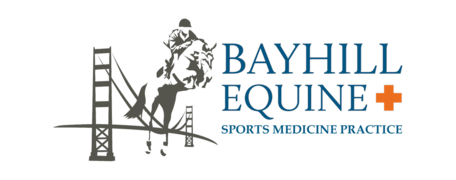Deworming
Health Tips

Internal Parasites and Your Horse
While a very simple practice in theory, knowing when to deworm, with what product and how often can become a very perplexing matter. This page will help to summarize the signs of parasitism, internal parasites of concern to horses, commonly used deworming (anthelmintic) products, goals of deworming and general recommendations for a deworming schedule. It is important to emphasize that variations in individual animals and farm management play a major role in the parasite burdens that our horses experience. While this article addresses the general management practices of our clients it is important to consult with one of the Bayhill veterinarians for a more personalized approach to your deworming program.
Please read below for the following:
Signs of Parasitism, Internal Parasites of Greatest Concern, Anthelmintic (Deworming) Products and Deworming Recommendations.
Signs of Parasitism
poor hair coat
pneumonia
colic
blockage or perforation of the GI tract
diarrhea
anemia
weight loss
hay belly
anorexia
decreased performance
Internal Parasites of Greatest Concern: Ascarids (roundworms): usually found in horses 18 months of age and younger, can cause lung disease, colic, weight loss, and diarrhea
Bots: flies commonly lay these yellow eggs on the legs, eggs are ingested with regular grooming behavior and establish residence in the stomach, they can cause irritation around/in the mouth, stomach ulcers, and colic
Pinworms: eggs are laid in perianal region resulting in tail rubbing as the most common indication of an infection
Large Stronglyes (bloodworms): these worms migrate through arteries in the abdomen and can cause damage of internal organs, weight loss, anemia, and colic
Small Strongyles (cyathostomes): considered the primary parasite of concern in equines, this worm is able to dig into and encyst in the lining of the large intestines, evading the body’s natural immune system and anthelmintics
Tapeworms: these worms are very difficult to detect on fecal analysis and also have fewer medications that are effective against them, can cause colic and intestinal blockage
Threadworms: these eggs are passed to foals through the mare’s milk and may cause diarrhea in the young
Anthelmintic (Deworming) Products
Avermectins
Ivermectin
Equell, IverCare, Rotectin, Zimectrin, etc.
Effective against: large and small strongyles (non encysted small strongyles), pinworms, ascarids, lungworms, threadworms, bots
Moxidectin
Quest
Similar effect as ivermectin and also has some action on encysted small strongyles
Praziquantel
with Ivermectin
Equimax, Zimectrin Gold
Same as ivermectin plus tapeworm control
with Moxidectin
Quest Plus
Same as moxidectin plus tapeworm conrol
Benzimidazoles
Fenbendazole
Safe-Guard paste, Safe-Guard POwer DOse, Panacur Paste and Panacur Powerpac
At normal dose effective against large stronglyes, pinworms, ascarids
At double dose for 5 days also effective against migrating large stronglyes, migrating ascarids, and encysted small strongyles
Oxibendazole
Anthelcide EQ
Effective against large stronglyes, pinworms, ascarids, threadworms
Not effective against encysted small stronglyes
Pyrantel Salts
Pyrantel Pamoate
Strongid Paste, Rotectin P, Equi-Cide, Liqui-Care P, TapeCare Plus, Pyrantel Pamoate Paste
Effective against large strongyles, pinworms, ascarids, tapeworms (at double dose)
Pyrantel Tartrate
Strongid C, Strongid C2X, Continuex, and Equi Aid CW-2W
This product is found in daily dewormers
Effetive against large strongyles, pinworms, and ascarids
Deworming Recommendations
When developing a deworming schedule it is important to understand the goals of deworming. We are not trying to completely remove all internal parasites each time we treat the horse. Instead the goal is to reduce the potential exposure of future parasites by reducing the number that reach the environment and have the potential to be ingested by your horse. An additional goal is selecting the appropriate deworming drug and using it at the appropriate time. Anthelmintic resistance has become and will continue to be a growing concern in equine health. In order to help our clients reduce their impact on anthelmintic resistance and ensure the availability of effective drugs in the future, we are making the following deworming recommendations and will be carrying recommended products for your use:
Fall Vaccinations: Panacur PowerPac to target migrating and encysted strongyles
3 months later: Pyrantel or Oxibendazole product
Spring Vaccinations: Ivermectin plus Praziqantel product to target tapeworms
3 months later: Pyrantel or Oxibendazole product.
*Horses on pasture should receive two additional treatments per year.
*Horses on a daily dewormer should also receive the deworming products during Spring and Fall vaccinations as recommended above.
All horses have a natural resistance to parasites, though the individual response varies. The above recommendations are being made for the average horse in our region. Your horse’s natural ability to defend against internal parasites may be above or below average, meaning that a fewer or greater number of dewormings per year may be necessary. To tailor a deworming schedule specifically for your horse, a simple fecal analysis will need to be submitted. Please contact the office if you are interested in creating an individual deworming plan or have questions regarding this article.
Adapted from “Get Rotation Right: How to reduce parasite burdens and resistance issues in your horse.” By Intervet-Schering Plough Animal Health
